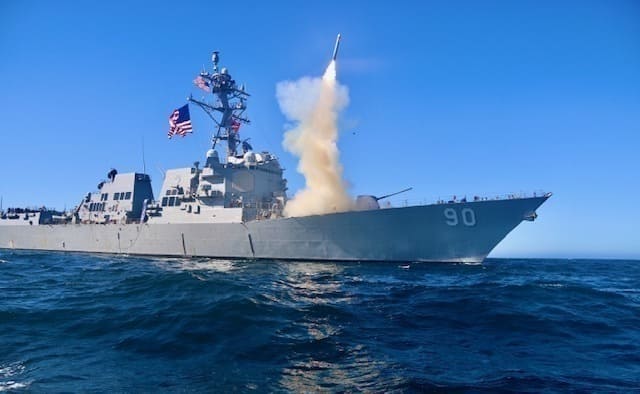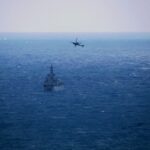The U.S. Navy will expand the number of Tomahawk cruise missiles configured for anti-ship missions with a new tranche of Block V upgrades to field the Maritime Strike Tomahawk seeker. Defense officials confirm the requirement covers from 35 to 96 missiles and the move will add more anti-ship capacity to the fleet as broader Block V recertification continues across the inventory.
The Defense-Aerospace editorial team reviewed the latest scope and notes it aligns with the service’s push to refresh a large stock of Block IV missiles rather than rely only on new production.
The upgrade inserts a maritime seeker suite and onboard processing that enable overwater target detection and discrimination at long range. The Navy is using the existing recertification pipeline to fold these changes into missiles timed for depot work, improving availability without creating a separate logistics tail. The service has kept the baseline navigation and communications improvements of Block V intact, so the seeker-equipped missiles gain both the new targeting function and the broader reliability and connectivity updates that the variant brings.
The plan complements ongoing modernization of production and certification facilities. The Navy has directed process and tooling updates at the missile recertification sites so the maritime seeker can flow through at scale when funding and material are in place. According to industry sources, this infrastructure work is a prerequisite for moving from dozens of seeker kits per year to higher rates if demand increases.
Maritime Strike Tomahawk Seeker, Warhead Options, and Variant Split
The program distinguishes two Block V subvariants. Block Va, often called the Maritime Strike Tomahawk, adds an over-water seeker for anti-ship engagements. Block Vb integrates the Joint Multiple Effects Warhead System, a multi-purpose warhead aimed at hardened or varied land targets.
Units can tailor loadouts by platform and mission, pairing seeker-equipped missiles for sea-control with Vb warheads for land attack. The seeker package bring back a capability fielded in limited form decades ago, now with modern processing and in-flight target updates. The Navy says the maritime seeker keeps the missile’s land-attack core intact. It lets crews shift the target set when needed.
This flexibility matters for surface combatants and submarines that must balance anti-ship and land-attack weapons within fixed vertical launch capacity. A prior lot of 42 seeker kits proved the installation flow and certification steps on Block IV airframes during recertification. During recertification, the team captured lessons that shaped current kit design, calibration procedures and software load integration, cutting touch labor and turnaround time at depot visits.
Seeker-equipped missiles remain compatible with existing launchers and command-and-control interfaces across destroyers, cruisers and attack submarines.
Who gets the work, when it ships and which allies are buying
The Navy plans to award the next upgrade work in the second quarter of Fiscal Year 2026, with completion expected roughly two years after award.
RTX, formerly Raytheon, is the intended prime based on its role as the Tomahawk’s original manufacturer and current Block V producer. The company already holds contracts for new-build Block V missiles and for recertifying Block IV to Block V, which lets seeker integration ride on established lines and quality systems.
Congress retains the option to expand quantities beyond the 35–96 window if funding is appropriated. Navy long-term documentation lists up to 3,992 Block IV missiles as candidates for recertification to Block V, a pool large enough to scale maritime seeker numbers if operational demand points that way.
A recent $400 million order for 131 Block V missiles across U.S. services and close partners, including Australia and Japan, underscores industrial momentum and allied interest in the common configuration.
Defense officials confirm the Navy’s acceptance process now accounts for seeker performance along with the broader reliability standards tied to Block V recertification.
Key program figures:
- 35-96 Block V missiles set to receive maritime seekers in the next tranche
- Award planned for Q2 FY26; approximately 24 months to complete the lot
- Up to 3,992 Block IV missiles eligible for Block V recertification over time
- $400 million for 131 Block V missiles awarded earlier in 2025 to U.S., Australia, Japan
- 42 Maritime Strike Tomahawk seeker kits delivered in a prior lot to validate the path
Which ships and subs will carry the upgraded Tomahawks and how they’ll use them
Surface combatants see the most immediate gain. They run mixed magazines and need credible anti-ship reach across the Pacific and other theaters. The seeker-equipped Block Va gives destroyers a heavy, long-range shot that complements SM-6 and the air-launched LRASM. For submarines, the upgrade widens stand-off choices when sea control or denial sits alongside strike tasking, all from the same launch cells and handling gear already in service.
The Navy’s training and tactics community has been tightening the targeting chain so ships can pass accurate updates and manage seeker behavior in complex maritime environments. Work includes deconflicting contacts, running emissions control, and aligning rules of engagement for over-the-horizon shots. Industry sources say recent software baselines tie the missile in more tightly with fleet networks, so the seeker arrives in the right search area with current track data.
The Block Vb warhead path continues in parallel. On some platforms, commanders will prefer a blended loadout – Va for ships, Vb for land targets – so the strike group can answer shifting tasking without returning to port. The mix runs on the same interface and fire-control logic, which keeps crew workload steady while doctrine keeps evolving.
If Congress expands seeker-kit buys, depots will need throughput headroom and material on hand to avoid bottlenecks. The Navy has set the conditions by updating certification facilities and aligning quality gates, but sustained funding is what turns those preparations into volume.
Near ter,m the 35-96 missile window adds a useful layer to the fleet’s sea-control posture. It is not a standalone solution. It sits beside sensor upgrades, targeting networks, and other weapons, changing how a strike group fights. Our analysis shows the choice to ride the recertification pipeline, rather than build a separate conversion line, keeps costs and risk in check while moving usable capacity into magazines within the current program plan.
REFERENCE SOURCES
- https://www.newsweek.com/us-news-navy-anti-ship-tomahawk-missile-china-military-2080100
- https://www.navalnews.com/naval-news/2025/07/u-s-navy-to-upgrade-more-tomahawks-with-anti-ship-capability/
- https://www.bairdmaritime.com/security/weaponry/us-navy-seeking-to-further-enhance-anti-ship-capability-of-tomahawk-missiles
- https://sam.gov/opp/a5ed3bd91b7a49cbb623591a811ea88c/view
- https://www.defense.gov/News/Contracts/Contract/Article/3479250/
- https://www.rtx.com/raytheon/news
- https://www.afcea.org/signal-media/navy-awards-contract-raytheon-tomahawk-missiles
- https://comptroller.defense.gov/Portals/45/Documents/defbudget/FY2025/FY2025_Budget_Request_Overview_Book.pdf
- https://www.navair.navy.mil/product/Tomahawk
- https://www.esd.whs.mil/Portals/54/Documents/FOID/Reading%20Room/Selected_Acquisition_Reports/FY_2023_SARS/TACTOM%20MSAR%20Dec%202023.pdf



